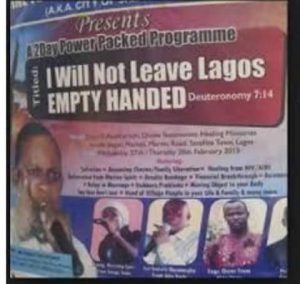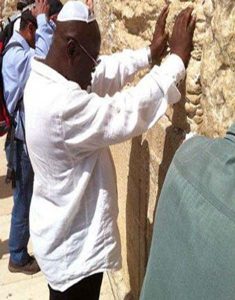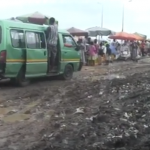While we slumber and pray
Posted by By Akogun Akomolafe at 4 November, at 15 : 00 PM Print

Warning: count(): Parameter must be an array or an object that implements Countable in /home/alaye/public_html/wp-content/themes/Video/single_blog.php on line 56




When are we in Africa going to realize how far behind the other races we truly are?
When are we going to wake up, rub the slumber from our eyes, gird our loins and try to do some catch-up?
The title of an interesting story in the October 5, 2011 edition of the WIRED magazine written by Adam Mann reads: “The Plan to Bring an Asteroid to Earth.”
Here is the story in full: “Send a robot into space. Grab an asteroid. Bring it back to Earth orbit.
This may sound like a crazy plan, but it was discussed quite seriously last week by a group of scientists and engineers at the California Institute of Technology. The four-day workshop was dedicated to investigating the feasibility and requirements of capturing a near-Earth asteroid, bringing it closer to our planet and using it as a base for future manned spaceflight missions.
This is not something the scientists are imagining could be done some day off in the future. This is possible with the technology we have today and could be accomplished within a decade.
A robotic probe could anchor to an asteroid made mostly of nickel-iron with simple magnets or grab a rocky asteroid with a harpoon or specialized claws (see video below) and then push the asteroid using solar-electric propulsion. For asteroids too big for a robot to handle, a large spacecraft could fly near the object to act as a gravity tractor that deflects the asteroid’s trajectory, sending it toward Earth.
“Once you get over the initial reaction — ‘You want to do what?!’ — it actually starts to seem like a reasonable idea,” said engineer John Brophy from NASA’s Jet Propulsion Laboratory, who helped organize the workshop.
In fact, many of these ideas have been on the drawing board for years as part of NASA’s planetary defense program against large space-based objects that might threaten Earth. And there’s no shortage of potential targets. NASA estimates there are 19,500 asteroids at least 330 feet wide — large enough to detect with telescopes — within 28 million miles of Earth.
Though rearranging the heavens may seem an excessive undertaking, the mission has its merits. The Obama administration already plans to send astronauts to a near-Earth asteroid, a mission that would coop them up in a tiny capsule for three to six months, and involve all the risks of a long deep-space voyage. Instead, robots could shoulder some of that burden by bringing an asteroid close enough for astronauts to get there in just a month.
Parking an asteroid in a gravitationally neutral spot between the Earth and the sun, known as a Lagrange point, would provide a stationary base from which to launch missions further into space. There are several advantages to this. For one, launching materials from Earth requires a lot of power, fuel, and consequently money, to get out of our planet’s deep gravity well. Resources mined from an asteroid with very little gravitational pull could be easily shuttled around the solar system.
And many asteroids have a lot to offer. Some are full of metals such as iron, which can be used to build space-based habitats while others are up to one-quarter water, which would be either used for life-support or broken down into hydrogen and oxygen to make fuel. As well, asteroid regolith placed around a spaceship hull would shield it against radiation from deep space, allowing safer travel to other planets.
An asteroid could be an alternative to setting up camp on the moon, or complement a moon base with more resources for heading further out in the solar system, said engineer Louis Friedman, co-founder of the Planetary Society and another co-organizer of the Caltech workshop.
There’s also the potential for mining asteroid materials to bring back to Earth. Even a small asteroid contains roughly 30 times the amount of metals mined over all of human history, with an estimated worth of $70 trillion. And astronomers would have the chance to get a close-up look at one of the solar system’s earliest relics, generating important scientific data.
Though technically feasible, budging such a hefty target — with a mass in excess of a million tons — would not be easy.
“You’re moving the largest mother lode imaginable,” said former astronaut Rusty Schweickart, cofounder of the B612 Foundation, an organization dedicated to protecting Earth from asteroid strikes.
Most asteroids are irregular chunks of rock that spin chaotically along irregular axes. Engineers would need to be absolutely certain they could control such a potentially dangerous object. “It’s the opposite of planetary defense; if you do something wrong you have a Tunguska event,” said engineer Marco Tantardini from the Planetary Society, referring to the powerful 1908 explosion above a remote Russian region thought to have been caused by a meteoroid or comet. Of course, any asteroid brought back under the proposed plan would be too small to cause a repeat of such an event.
Still, these obstacles are like catnip to engineers, who love to go over every potential difficulty in order to solve it. Actually executing the asteroid retrieval plan would help demonstrate and greatly expand mankind’s space-based engineering capabilities, said Friedman. For instance, the mission would teach engineers how to capture an uncooperative target, which could be good practice for future planetary defense missions, he added.
And if the challenges for a large asteroid seem too daunting, researchers could always start with a smaller asteroid, perhaps six to 30 feet across. Gradually larger objects could be part of a campaign where engineers learn to deal with progressively greater complications.
Last year, Brophy helped conduct a study at JPL to look at the feasibility of bringing a 6.5-foot, 22,000-pound asteroid — of which there might conceivably be millions — to the International Space Station. This mission would help astronauts and engineers learn how to process asteroid materials and ores in space.
The JPL study suggested the asteroid could be captured robotically in something as simple as a large Kevlar bag and then flown to the space station or placed in a Lagrange point. Of course, such a small object might not have the same emotional impact as a larger destination. “NASA isn’t going to want to go to something that is smaller than our spaceships,” said engineer Dan Mazanek from NASA’s Langley Research Center.
No matter the size of the asteroid, these plans would require hefty investments. Even capturing a small asteroid would consume at least a billion dollars and anything larger would be a multi-billion-dollar endeavor. Convincing taxpayers to foot such a bill could be tricky.
Considering the resources available in any asteroid, private industry might be interested in getting involved. One possible mission would be to simply execute the first part of the plan — pushing the asteroid to near-Earth orbit — and then convene a commercial competition inviting anyone who wants to develop the capabilities to reach and mine the object.
Though the undertaking might be scientifically exciting, this wouldn’t be the primary motivation. An asteroid would provide great insight into the solar system’s formation, it’s not enough to justify the expense of bringing one to Earth. Any interesting science can be done much cheaper with an unmanned robotic spacecraft, said chemist Joseph A Nuth from NASA’s Goddard Spaceflight Center.
“Ultimately, we would be developing this target in order to help move out into the solar system,” Brophy said.
Though they did not reach a consensus on all the details, the group will reconvene in January to hammer out further specifications and potentially get the interest of NASA.
In the end, many agreed that bringing an asteroid back to Earth could create an interesting destination for repeated manned missions and that the undertaking would help build up experience for future jaunts into space.”
Hmmmmm!




I spent three unforgettable weeks in the United States of America in August of 2011. There are many things wrong with that country but no one will visit that country from Africa and ever be the same again.
The technical, scientific, engineering and technological accomplishment of the country is all there for all to see, and they are truly humbling, especially for people from our part of the world where people still sleep their way through life believing that goblins of the skies are coming to take care of human affairs.
The gap between us and the Americans are just too wide that we can forget about bridging it anytime soon. Not unless we can find a way for them to stop and wait for us to catch up with them.
Since it would be foolish to think that they will do it, we can forget this proposition.
The sad thing is that our leaders – political, economic, academic and religious – travel regularly to the US, and they see firsthand what human beings have been able to accomplish with sheer human ingenuity. They see all the technological accomplishments of mere mortals. They see and use all the electronic marvels created by human brains.
Bafflingly, they come back and continue with the same attitude of sheer complacency. They continue to behave like we are not too far behind and we have no need to hurry to tag along (forget to catch up).
They continue to tell us stupid and insane lies about a saviour Jesus who is coming to take care of things for us.




We have leaders telling us odious lies like ‘God is in charge,’ like a god has done a darn thing for any human society.
We have blasted charlatans, attired in their lying cassocks, telling us that we need only double or triple our prayer efforts and all shall be well. We witness daily the stupid charades of prayers and retreats.
These leaders will not tell us what single human problem can be solved with adjuration to gods. They do not tell us why they don’t rely on prayers to give them the same material comfort they buy with money extorted from their ignorant congregation.
These totally shameless imposters, who pretend to stand between us and some gods, will not tell us why they live their own paradise here on earth rather than wait for it in heaven. They don’t tell us why they are never in a hurry to meet their father in heaven where everything is supposedly blissful.
So, while we are busy with our prayer camps, Holy Ghost fire, impartation retreats, anointing oil, candles, incense, prophesying, speaking in tongues and other utterly stupid abracadabra, human beings are busy thinking about how to capture an asteroid and mine its minerals!
Enuf said!


About the Author
Femi Akomolafe, a passionate Pan-Africanist, was one of the PCs Pioneers and ran a Computer Consultancy firm in Amsterdam, the Netherlands for several years, where he also set up the first African Bulletin Board System (BBS), the precursor to the Internet. He also established the first Black Newspaper, The African, in the country.
Femi has been very active in the Pan African Movement since the early 1990s.
A columnist for ModernGhana and a Correspondent for the London-based New African magazine, Femi lives in both Europe and Africa and writes regularly on Africa-related issues for various newspapers and magazines.
Femi was the producer of the FOCUS ON AFRICANS TV Interview programme for the MultiTV Station.
He is also the Man and Machine Coordinator at Alaye Dot Biz Limited, a Kasoa-based Multimedia organization that specializes in Audio and Video Production. He loves to shoot and edit video documentaries.
He is currently engaged in vegetable farming.
His highly-acclaimed books (“Africa: Destroyed by the gods,” “Africa: It shall be well,” “18 African Fables & Moonlight Stories” and “Ghana: Basic Facts + More”) are available for sales at the following bookshops/offices:
- Freedom Bookshop, near Apollo Theatre, Accra.
- WEB Dubois Pan-African Centre, Accra
- Ghana Writers Association office, PAWA House, Roman Ridge, Accra.
Where to buy them online:
On Lulu Books:
18 African Fables & Moonlight Stories https://goo.gl/Skohtn
Ghana: Basic Facts + More: https://goo.gl/73ni99
Africa: Destroyed by the gods: https://goo.gl/HHmFfr
Africa: It shall be well: https://goo.gl/KIMcIm
Africa: it shall be well
on Kindle books: https://www.createspace.com/4820404
on Amazon books: http://goo.gl/QeFxbl
on Lulu Books: https://goo.gl/SQeoKD
Africa: Destroyed by the gods
on Kindle books: https://www.createspace.com/4811974
18 African Fables & Short Stories: https://goo.gl/s9tWAf
on Amazon books: http://goo.gl/1z97ND
on Lulu Books: http://goo.gl/KIMcIm
My Lulu Books page: http://www.lulu.com/spotlight/FemiAkomolafe
Get free promotional materials here:
- Africa: it shall be well: http://alaye.biz/africa-it-shall-be-well-introduction-in-pdf/
A FREE Chapter of ‘Africa: It shall be well’ can be downloaded here: http://alaye.biz/africa-it-shall-be-well-a-free-chapter/
- Africa: Destroyed by the gods (How religiosity destroyed Africa) http://alaye.biz/africa-destroyed-by-the-gods-introduction/
A FREE Chapter of ‘Africa: Destroyed by the gods’ can be downloaded here: http://alaye.biz/africa-destroyed-by-the-gods-free-chapter/
Contact Femi:
Femi’s Blog: www.alaye.biz/category/blog
Website: www.alaye.biz
Femi on Amazon https://www.amazon.com/author/femiakomolafe
Femi Akomolafe’s Lulu Books page: http://www.lulu.com/spotlight/FemiAkomolafe
Twitter: www.twitter.com/ekitiparapo
Facebook:https://www.facebook.com/Femi Alaye;
Gmail+: https://plus.google.com/112798710915807967908;
LinkedIn: www.linkedin.com/in/femiakomolafe;
YouTube Channel: https://www.youtube.com/user/fakomolafe
Email: fakomolafe@gmail.com
Profile on New African magazine: http://newafricanmagazine.com/tag/femi-akomolafe/
Kindly help me share the books’ links with your friends and, grin, please purchase your copies.
Comradely,
Femi Akomolafe




